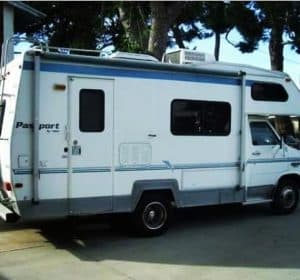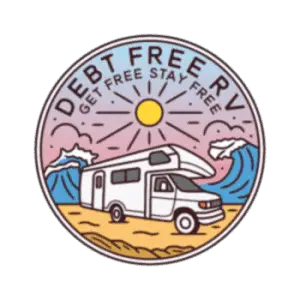Our Debt Story:
How We Paid Off $53,000 In An RV!
Student loan debt gave me anxiety. And making payments toward a $52,500+ loan was like a slow-motion heart attack stretching over four years.
Like so many other college graduates, I left school with a BA, MA, and negative money in the bank.
Minimum payments were a little over $300 per month, but if you’ve ever had the pleasure of paying this particular Piper, you know that minimum payments won’t get you out of debt.
With interest accruing faster than your body can make tears, without a plan to pay them off you could be in debt for a very long time.
After graduation, I started making payments slightly over the minimum (an extra $50-$75) every month. At the time, my husband was looking for work, so having a single income made larger payments difficult.
For two years, we were basically treading water.
Throwing a little extra toward the monthly payments was barely making a dent in the principle, but at least the debt wasn’t getting any bigger- we were keeping the interest at bay.
But this high wire act couldn’t last forever: Apartment rent goes up an average of $100 per year (in southern California), and the general cost of living is one of the highest in the country.
The Accident
During the third year of Operation Loan Payoff, my husband found a job. We were excited that life was about to get a little bit easier, and we could start making some headway on our financial future.
Unfortunately, his new boss had no intention of paying her employees, and a couple months into his new job, with no paycheck, my husband was in a car accident early on Christmas morning.
Another car T-boned him, with the other car flipping over, and my husband’s truck totaled.
Nobody was hurt, but my husband walked away from the accident in slight shock, with no paycheck, and no mode of transportation. This is the stuff country songs are made of.

The Decision
But then the stars aligned: In the weeks following the accident, the insurance company sent us a $8000 check for his totaled truck. And we found ourselves at a crossroad.
Would we use this money for rent, lasting us less than eight months, or would we seriously consider another option like trying a RV? Could we really leave rent behind and pay off all our debt?
We needed a way to pay off debt quicker…
So we started doing serious reconnaissance: Checking Craigslist postings for RVs, researching surrounding cities and their RV laws, reading community forums to see which areas were more “friendly” to RVs/vans, and we drove through areas we thought might be good for “stealth parking” overnight.
After a few weeks of research and a thorough Cost-Benefit Analysis, we decided to take the leap.
We were getting out of debt.
The RV
Finding RVs on Craigslist was easy… finding a good quality RV is another story. We looked at a total of five, driving down to San Diego, up to Los Angeles, and cities in between.
All of the RVs looked great online, but in person, we saw big problems: The first RV’s bathroom floor was rotted (which we almost fell through), the second was a death trap on wheels (steering wheels should do something, right?), yet another had huge holes in the walls and were amateurly packed with… well, that remains a mystery.

But our fifth trip out we found what we were looking for: a well-kept, 1992 Cobra Passport 19″ for $8000. We signed a cashier’s check, christened our new home Petunia Marigold, and were officially on our way to (eventual) financial freedom.
Our new life trajectory was starting to take shape and was becoming a reality.
The Money
Before moving in to our RV, I documented our daily spending and our monthly take-home income for over a month.
By the time we left apartment life, we knew exactly how much we were bringing in, how much was being spent on necessities, and how much was being “wasted” on frivolous things (*this remains a daily habit).
Without $1100 per month in rent, we were able to start putting large chunks of money toward paying off our debt.
Some of the would-be rent money went to pay the slight increases on our auto insurance, RV gas and propane, and also went to a savings account to get us through summer (my primary jobs are in schools, so I’m not paid for the months of June, July or August).
But even with these expenses, we were able to throw anywhere between $750-$1750 per month towards our debt. Doing this, we became debt free in less than four years.
The How
Maybe that last sentence made the journey seem like magic: RV = Debt Free.
But the reality is filled with more perseverance, hope and self-discipline over the course of four years.
The honest formula to our debt free life includes: an honest look at our finances (how much we bring in monthly, how much we spend and on what), discipline, and a massive cut on frivolous purchases.
During Operation Loan Payoff, we rarely went out for dinner- those outings were saved for birthdays and our anniversary.
We cut out other unnecessary items such as coffee, new clothes, Netflix, etc.
Instead, we found things to replace these purchases, so we didn’t become completely ascetic.
Here’s an example: I’m an unapologetic caffeine addict…
But Starbucks just twice a week can cost between $4-$12 each visit.
Instead, I buy bags of organic, black tea powder with 125 servings of high octane brain power for $14 per bag; This works out to $0.11 per serving versus a $4 cup of tea at Starbucks.
Over a month, this saves a good chunk of change which we’d then throw at our debt.
If you want to pay off your debt, know that on this journey ALL of these seemingly small purchases add up over the course of a month- every purchase does matter.
Becoming debt free requires planning, analysis, and grit.
Here’s the basics:
1. Decide that you want to be debt free. This sounds simple, but for many, it’s a major struggle. This decision is both your foundation and your North Star when the going gets tough. And there will be times when it’s tough.
2. Analyze your daily/monthly spending habits. In order to make any real headway you need to know exactly how much you’re bringing in, how much you’re spending (and on what).
3. Be Honest with yourself. When you’re going through your analysis, make sure you know the difference between true needs and wants.
4. Automate everything possible. Setting up automatic monthly payments will not just lessen stress levels, but depending on the company, you may be able to reduce costs. Check your credit cards, student loans, phones and any other payments to see if they offer a discounted rate for setting up auto-pay.
5. Envelope System you money (or use a similar system). Popularized by Dave Ramsey, the Envelope System keeps you honest and disciplined with your money.
6. Keep Going even when times get tough, when friend and family aren’t on-board/don’t understand, and when those dark days come and you wonder if a debt free life is really possible. It IS possible. And when you get to the other side you’ll be so happy that you just. kept. going.
